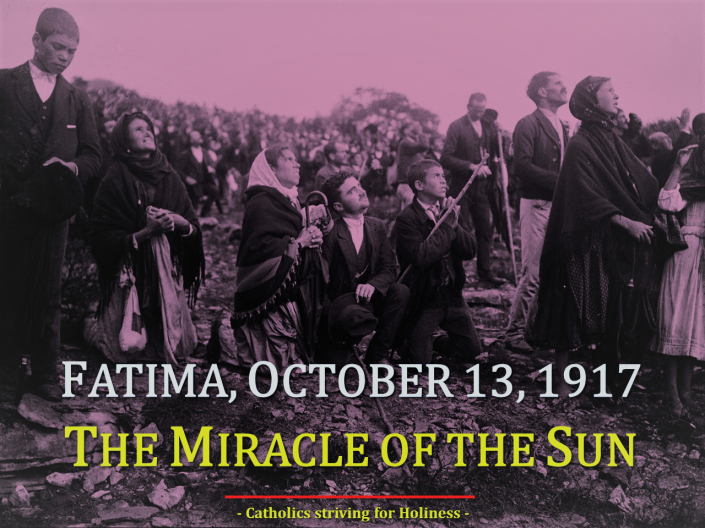
“Then, suddenly, one heard a clamor, a cry of anguish breaking from all the people.
The sun, whirling wildly, seemed all at once to loosen itself from the firmament and,
blood red, advance threateningly upon the earth as if to crush us with its huge
and fiery weight. The sensation during those moments was truly terrible”.
Dr. José Maria de Almeida Garrett
The Miracle of the Sun
An Eyewitness Account by Dr. José Maria de Almeida Garrett, professor at the Faculty of Sciences of Coimbra, Portugal
"It must have been 1:30 p.m when there arose, at the exact spot where the children were, a column of smoke, thin, fine and bluish, which extended up to perhaps two meters above their heads, and evaporated at that height. This phenomenon, perfectly visible to the naked eye, lasted for a few seconds.
Not having noted how long it had lasted, I cannot say whether it was more or less than a minute. The smoke dissipated abruptly, and after some time, it came back to occur a second time, then a third time.
"The sky, which had been overcast all day, suddenly cleared; the rain stopped and it looked as if the sun were about to fill with light the countryside that the wintery morning had made so gloomy. I was looking at the spot of the apparitions in a serene, if cold, expectation of something happening and with diminishing curiosity because a long time had passed without anything to excite my attention. The sun, a few moments before, had broken through the thick layer of clouds which hid it and now shone clearly and intensely.
"Suddenly I heard the uproar of thousands of voices, and I saw the whole multitude spread out in that vast space at my feet...turn their backs to that spot where, until then, all their expectations had been focused, and look at the sun on the other side. I turned around, too, toward the point commanding their gaze and I could see the sun, like a very clear disc, with its sharp edge, which gleamed without hurting the sight. It could not be confused with the sun seen through a fog (there was no fog at that moment), for it was neither veiled nor dim. At Fatima, it kept its light and heat, and stood out clearly in the sky, with a sharp edge, like a large gaming table. The most astonishing thing was to be able to stare at the solar disc for a long time, brilliant with light and heat, without hurting the eyes or damaging the retina. [During this time], the sun's disc did not remain immobile, it had a giddy motion, [but] not like the twinkling of a star in all its brilliance for it spun round upon itself in a mad whirl.
"During the solar phenomenon, which I have just described, there were also changes of color in the atmosphere. Looking at the sun, I noticed that everything was becoming darkened. I looked first at the nearest objects and then extended my glance further afield as far as the horizon. I saw everything had assumed an amethyst color. Objects around me, the sky and the atmosphere, were of the same color. Everything both near and far had changed, taking on the color of old yellow damask. People looked as if they were suffering from jaundice and I recall a sensation of amusement at seeing them look so ugly and unattractive. My own hand was the same color.
"Then, suddenly, one heard a clamor, a cry of anguish breaking from all the people. The sun, whirling wildly, seemed all at once to loosen itself from the firmament and, blood red, advance threateningly upon the earth as if to crush us with its huge and fiery weight. The sensation during those moments was truly terrible.
"All the phenomena which I have described were observed by me in a calm and serene state of mind without any emotional disturbance. It is for others to interpret and explain them. Finally, I must declare that never, before or after October 13 [1917], have I observed similar atmospheric or solar phenomena." ….
Professor Almeida Garrett's full account may be found in Novos Documentos de Fatima (Loyala editions, San Paulo, 1984)
